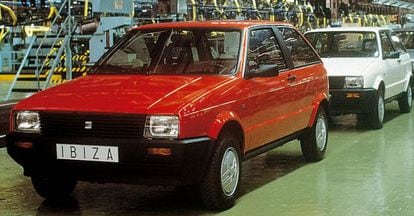Ibiza: the car that saved Seat
Spanish carmaker’s top-selling auto was a patchwork model, with Italian design and a German body


It has seen five million units sold in 75 countries, and over its three decades of existence has become the brand’s top-selling model. The Seat Ibiza had a lot to celebrate on its 30th birthday last week.
The Ibiza, which is now into its fourth generation, was born in 1984 at Seat’s now-defunct factory in Barcelona’s Zona Franca. The plant, which once employed 33,000 people, had sticky floors, was freezing cold in the winter and boiling hot in the summer, and saw its cars dragged around with chains. The concept of occupational hazards was not in the managers’ lexicon back then.
The engine of the first model had 44 horsepower, while the finished item cost 825,000 pesetas – close to €5,000, which would be around €15,600 today.
But the Ibiza was a lot more than a best-selling model: it was the car that saved the company. In 1984, the Italian car maker Fiat had just pulled out of the Spanish car maker, which reverted to the National Industry Institute (INI). Meanwhile, Volkswagen was pondering whether it would be worth buying a Spanish brand that had a commercial network, but whose cars were not much more than replicas of the Fiat models.
The old factory was freezing in winter and boiling in summer
Vicenç Aguilera, former director of Seat’s Technical Center and currently president of the Automotion Cluster of Catalonia association, joined Seat in 1982.
“The Ibiza had been on the drawing board for a year, and it was a way to keep Volkswagen interested in us,” he recalls. The German company finally bought Seat on December 30, 1985.
The INI had commissioned a sketch from the prestigious Italian designer Giorgio Giugiaro. But the draft came with no engine or gearbox.
A top seller
Production: 4,976,451 units spanning four generations of Ibiza
Price: Went on sale for 824,000 pesetas (€4,952, which at today's prices would be €15,620). It is currently available for €8,900
Exports: 69 percent of all sales are exports. In 2013 exports represented 85 percent of production
Current production: 700 units a day
“That [project] materialized thanks to a group of people who had the balls to go and see the engineers over at Porsche,” says an industry source.
The Ibiza was a patchwork car. Its design was Italian, its body German, and its engine was put together in such a way by Porsche’s engineers that it would adapt to Seat’s existing technology at the Barcelona plant. The icing on the cake was the name someone came up with for the car: Ibiza, the Mediterranean island that conjured up visions of the sea, parties and youthful abandon.
In fact, the nomenclature was such a success that years later executives at Volkswagen Group seriously considered changing Seat’s name to Ibiza altogether.
The car did very well from day one, and in just a short while Seat pulled back from the brink and began seeing a future for itself.
“The Ibiza represented survival, it was a vital contribution,” concludes Aguilera.
The second-generation Ibiza was made at the brand new factory in Martorell, in 1993.
The car also got immediate international exposure. Of the five million units sold over the last three decades, 3.5 million were shifted outside Spain in Italy, France, Germany, Britain, Portugal and Mexico. And Seat execs say that having an Ibiza is a must in Israel. Last years, exports represented 85 percent of Ibiza sales.
Young people were the first to buy themselves an Ibiza, and it could well be that their children are now purchasing the fourth-generation model, which came out in 2008.
The current director of Seat’s Technical Center is Teo García, who has spent 41 of his 59 years with the company. “When we no longer had Fiat’s protection, we sought the most cutting-edge support we could find, and that is why we went to see Porsche,” he recalls.
The car came with an unknown luxury at the time: air conditioning
The car was advertised as “Ibiza with a System Porsche engine.”
“It was one level higher,” notes García, who also remembers another perk that made the car sell well: air conditioning. It was an unknown kind of luxury for a car in Spain at the time. A year-and-a-half later the car had powered door locks and electric windows. It also came with the possibility of installing a car radio, which people in Catalonia used to have to drive to Andorra to buy.
García also remembers that the prototypes were tested in North Africa and in Sweden, to see how the materials would react to extreme heat and cold. There were also some test runs on local racetracks. The cars were taken out at night, camouflaged to avert the reporters who were stalking them in the hope of sneaking a peek at the new Ibizas.
These days, the Martorell plants (10,000 employees, or 15,000 including Seat Componentes) are clean like an industrial kitchen, there is background music, and the car parts spend just three hours on the production line before they are complete. Both men and women work here now, as opposed to the early days, when female employees could only do cable work or sew the upholstery.
“Besides, the hardest work and the welding is done by robots these days, who also have greater precision. And working conditions have improved a lot,” explains Vicente Bayo, who was at the factory from the beginning, and retired just last week.
The Ibiza joins a select club of cars that can boast about having made it to 30, and which also includes the Volkswagen Golf, the Opel Corsa and the Ford Fiesta.
30 years of engines
The Seat Ibiza has evolved along with Spanish society, as is clear from its advertisements through the years. The first commercials show a five-door Ibiza – which was unusual for a compact car in the 1980s – and a group of youngsters on the island that gave the car its name. The second-generation Ibiza was the official vehicle of the Barcelona Games of 1992. Later it was advertised by celebrities, including the flamenco dancer Joaquín Cortés.
And that’s without even mentioning the engine’s evolution. The car started out with a range of options, from 44 horsepower to 100 horsepower in the gasoline version. In 1988 the SXI version with 100 horsepower was the prelude to the current CUPRA and FR. The second generation offered six different engines (gasoline, diesel and turbodiesel) and it was the first compact car with a TDI 90 HP motor. In 1994 the company rolled out the GTI, and in 1997 it introduced an automatic version of the car. Three years later the Ibiza was the first car of its kind to be equipped with Electronic Stability Control and the first serially produced sports model. In 2007 Seat introduced the low-emission Ibiza Ecomotive.










































